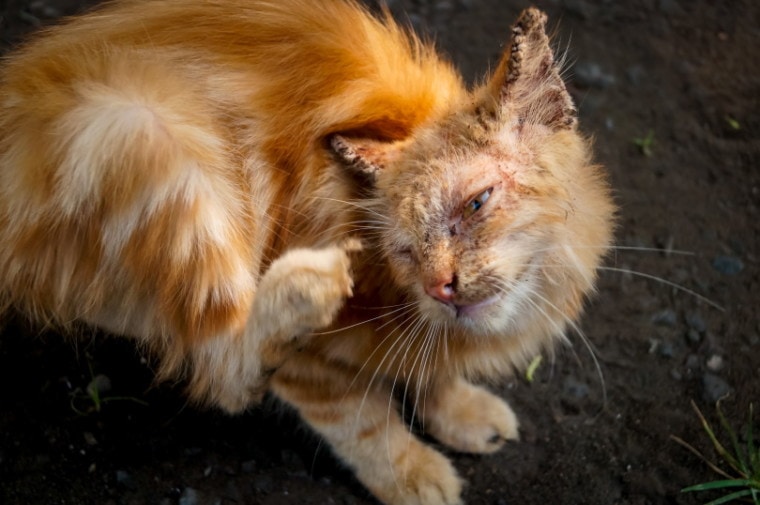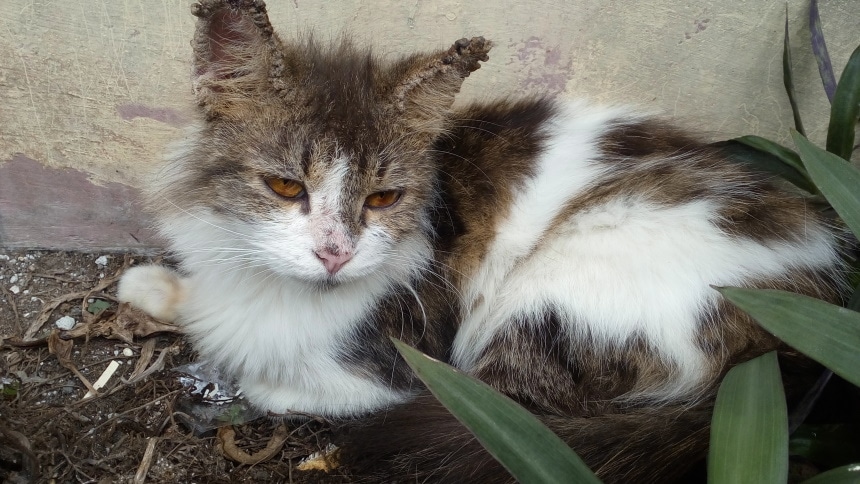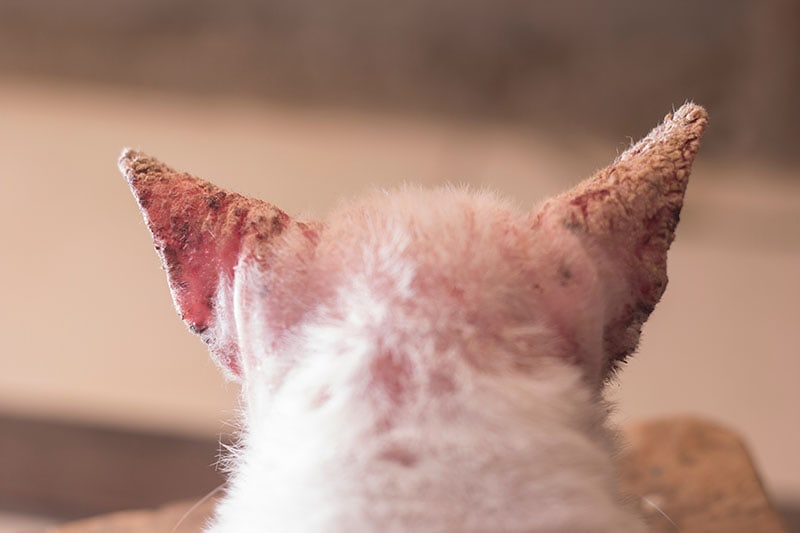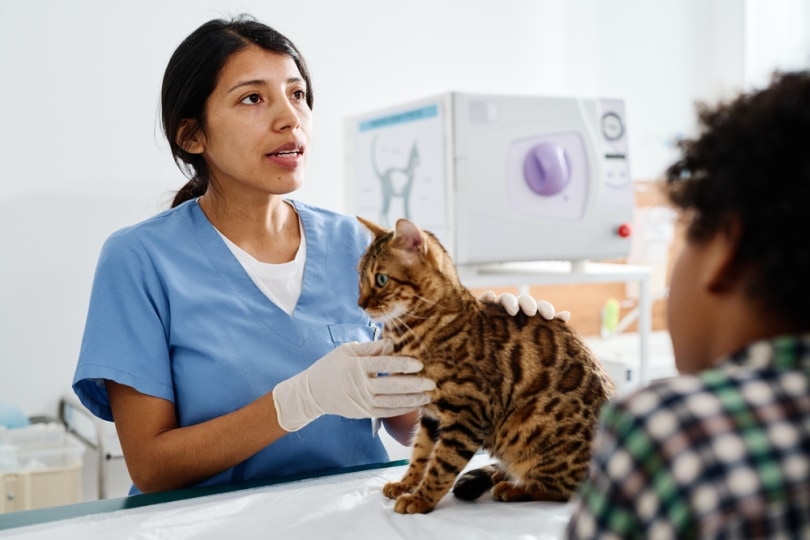
Does your cat have crusts on the tips of their ears or all over their body, and are they scratching themselves intensely? If the answer is yes, your cat may be infested with scabies.
Scabies or mange is uncommon in cats, but it can affect any cat, regardless of breed. It is contagious and can spread quickly to other pets, so it is crucial to treat it early. This skin disease is caused by microscopic mites that burrow deep into the layers of the skin, causing pets to scratch themselves to the point of self-mutilation.
Scabies is found all over the world and among many animal species, including humans. Cat owners must pay attention to their pets’ clinical signs and take them to the vet as soon as possible.
What Is Scabies?
Scabies in cats is an itchy, parasitic dermatosis produced by two species of mites. These mites preferentially affect certain areas of the body, especially areas that are hairless or have little hair. The female mites parasitize the surface of the skin. During the night, they dig tunnels to lay their eggs daily. The larvae will emerge on the surface of the skin to transform into nymphs, then adults.
The movement of the female and her metabolic products cause cats to scratch violently. Affected animals will present excessive itching and scratching and develop skin lesions and crusts.
Transmission occurs through direct contact with a sick animal, but cats can also pick up mites from grass, shelters, etc. This condition can develop in cats that live indoors and in those that have access to an exterior environment. A greater risk of infestation is presented by cats that come into contact with the outside environment. It mainly affects cats that have a low immune system, live in unsanitary conditions, or are fed a poor diet.
Scabies can be diagnosed easily when the clinical signs are obvious. It is a condition that can be treated but is highly contagious and can be transmitted to other animals, including humans.1 Owners must keep their pets in quarantine if they have been diagnosed with scabies.
If you do not treat scabies in time, it can spread over the entire surface of your cat’s body. Pets can even die if they are not treated when scabies generalize.

What Are the Signs of Scabies in Cats?
Scabies is a rare disease in cats but is highly contagious. Many cats are carriers, and the disease develops if the cat’s health deteriorates.
Although these mites can parasitize cats’ entire bodies, they prefer hairless or less-hairy areas, such as the ears, the joints of the legs, the tail, around the eyes, and the nose. The first symptoms appear 2–6 weeks after your cat has come into contact with an animal with scabies.
The first signs of scabies in cats usually appear on the tip of the ears, then descend on the face and affect the whole body if it is not treated in time.
Scabies cause severe itching and skin irritation, making cats lose their fur in the areas where they scratch more often and violently. At first, red spots appear on the skin, and cat owners may mistake this initial phase for trivial skin irritation.
What Are the Causes of Scabies?
Scabies in cats can be caused by two species of mites: Notoedres cati and Sarcoptes scabiei. The most common infestation in cats is with N. cati.
These mites dig tunnels in the deep layers of the skin, causing intense itching in the affected area. Only the female mites burrow in the skin. They do this to lay their eggs and feed (mites feed on dead cells and lymph). Eggs and excrement cause allergic reactions that translate into even stronger itching.
Infestation occurs mainly through direct contact with a sick animal. A simple touch is usually enough to cause infestation, as the mites can move quickly from one organism to another.
Cats that live in shelters, on the street, or in unhygienic conditions, even if they have an owner, are the most prone to getting infested with scabies. Cats with a weak immune system or other diseases and those that are fed poor-quality diets are also targets for these mites.
If your cat goes outside, don’t let them near stray animals that show signs of scabies, e.g., skin lesions, crusts, and itching. Even though it may seem like a simple irritation or a form of dermatitis, scabies is highly contagious.
If you know that your cat is infested with scabies, quarantine them, and do your best to keep them away from other animals.
Cats can also pick up scabies mites from vegetation, other open spaces, or places where there are several animals, such as shelters, though this is rare.
The parasite that causes scabies remains alive for 2–4 weeks on average, so your cat may still get sick even if direct contact with an infested animal has been ruled out.

The Life Cycle of Scabies Mites
Scabies mites have four stages in their life cycle: egg, larva, nymph, and adult. Transmission occurs primarily through the transfer of impregnated females. The females dig tunnels in the skin layers to lay eggs and feed. On average, a female lays two to three eggs per day for up to 6 weeks (until she dies).
Larvae hatch in 3–4 days and then migrate to the skin surface and stop at the stratum corneum (the outer layer of the skin) to dig burrows, which are called molting pouches. In these pouches, the larvae feed and turn into nymphs, then adults. The adult male enters the pouch and mates with the female. The female remains fertile for the rest of her life.
After mating, the male dies, and the female leaves the pouch to find a suitable place to lay her eggs.
How Do I Care for a Cat With Scabies?
If your cat shows signs of scabies, you should take them to the vet’s office as soon as possible and have them quarantined. It is also necessary to sanitize often, especially in places where your pet has stayed. Remember to use gloves when you come into contact with your cat for a few weeks after the treatment is over.
Strictly follow your veterinarian’s advice and instructions for the best results. The treatment lasts several weeks, so you have to be patient.
All pets that have come into contact with your infected cat must be treated. Remember that it can also spread to humans, even if humans are not the primary host.

Frequently Asked Questions (FAQs)
Can Dogs Get Scabies From Cats?
Cat scabies can indeed be transmitted to dogs, with Sarcoptes scabiei mites being the most common ones. Infestations with Notoedres cati mites are rare in dogs. Transmission is typically through direct contact with a sick cat. The signs of scabies in dogs are similar to those in cats: excessive itching, lesions, crusts, and hair loss. In dogs, so-called “elephant skin” can also occur. This happens when scabies spreads all over a dog’s body.
Can Cat Scabies Be Transmitted to Humans?
Scabies is a zoonotic disease, which means it can be transmitted from animals to humans. It is contagious for both animals and humans. Scabies caused by the mite Notoedres cati is the most common form of mange in cats, and as studies show, it can also be transmitted to humans. Scabies caused by Sarcoptes scabiei mites is less common in cats but is very common in dogs. This type of scabies is the one most often transmitted to humans.
How Does a Vet Treat Scabies?
If you suspect that your cat has scabies or if the vet has diagnosed your pet with scabies, a series of treatments will be prescribed depending on the severity. Usually, the treatment lasts several weeks and can include medicated baths and dips, topical medications (applied to the skin), pills, injections, chewable tablets, or oral liquids. Scabies is relatively easy to treat if it is diagnosed in time and does not become generalized.
Conclusion
Scabies in cats is a highly contagious skin disease caused by two species of mites, the most encountered being Notoedres cati. Transmission is through direct contact with a sick animal or from the environment. Scabies first occurs on the top of the ears and then descends on the face. In massive infestations, it can spread over the whole body. Female mites dig tunnels in the skin to lay eggs, which causes severe itching. Clinical signs occur 2–6 weeks after contact and include severe itching and scratching, lesions and crusts, and hair loss. Scabies is treatable and can rarely be fatal, but sick cats must be kept in quarantine.
Featured Image Credit: Suharji Esha, Shutterstock








